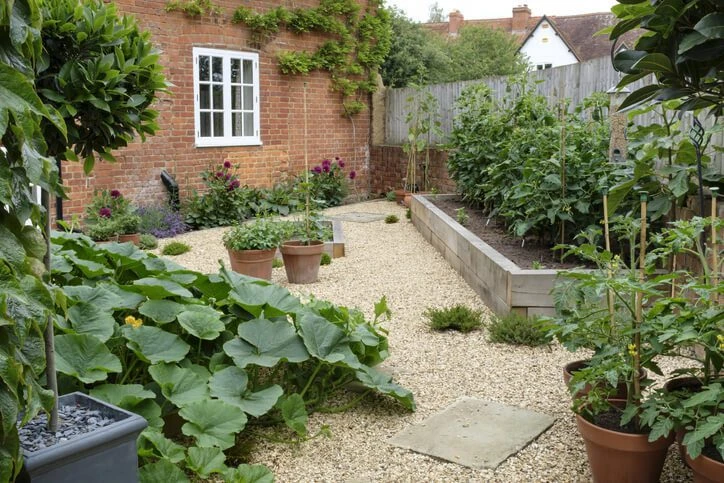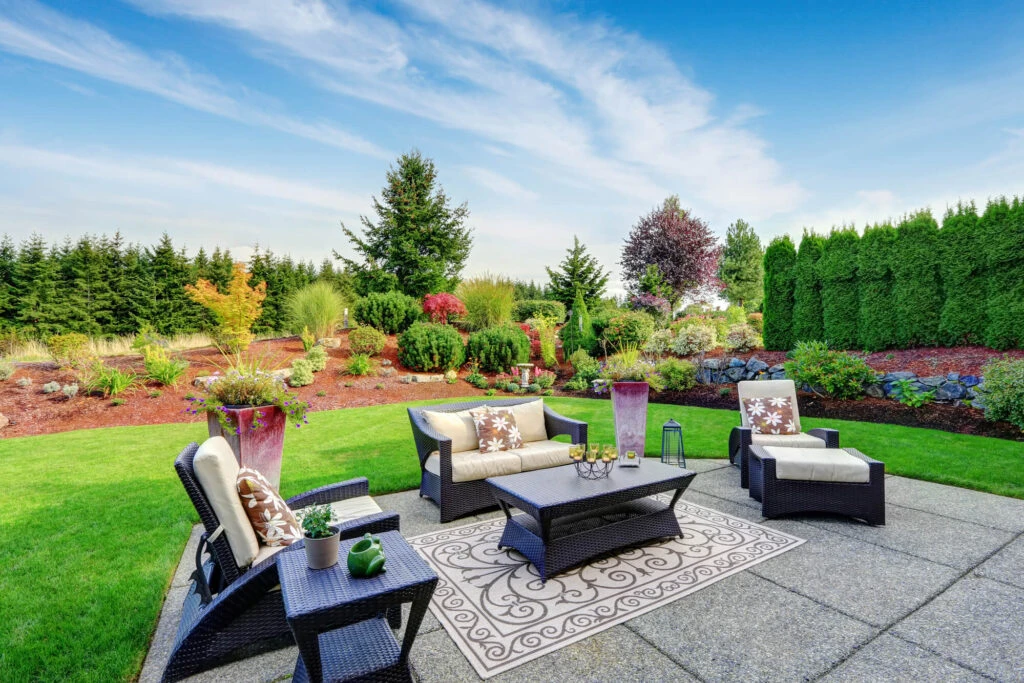Home courtyards are often found in the backyard of homes and are the finishing touch of most homeowner’s outdoor aesthetics. They are typically enclosed on 3-4 sides and are uncovered outdoor areas. At New Life Rockeries, we know exactly how to make your own backyard courtyard into something special to impress your guests.
Courtyards often have a sitting area and are used for hosting or dining during the summer months.
If you would like to design a courtyard for your home and are in search of ideas for your courtyard, this article is for you.
Whether you are looking for stone, modern, or traditional courtyard ideas, here are 7 creative backyard courtyard ideas to fuel your motivation!
1. Urban Backyard Courtyard
Urban backyard courtyards have a very uniform and city look to them.
They are maintained, organized, and have a few intentional and unique elements. They generally take on the form of a more modern courtyard with muted gray flagstone and grass as main features.
Elements
Use courtyard furniture that is primarily black or has many black accents. Go sparingly on flowers and instead choose leafy trees and moss for your courtyard garden. Consider adding wooden planter boxes and retro drop lights to finish off your urban courtyard aesthetic.
2. Natural Stone Courtyard Ideas
A much more natural courtyard design, this one uses stone and rock as the main design element and focuses on creating a wild aesthetic. Implement lots of grays, browns, greens, and earthy shades into this backyard courtyard design.
Elements
Utilize differently shaped stones; this will add a natural and wild feel to your courtyard. A wonderful example of stone water features could be a small stone water fountain in the center of your courtyard.
Opt for burnt and muted colored shrubbery and flowers as these will best accent your stone courtyard.
3. Mediterranean Backyard Courtyard
This is a fun and creative backyard courtyard concept for you.
Are you in love with Mediterranean vibes and design? If so, you will be glad to hear that you don’t need to go to Greece for a taste of some Meditteranean style. You can bring the Meditteranean to your backyard by creating a Meditteranean inspired courtyard!
Elements
Have a patio contractor install a Mediterranean patio as the main feature in your themed courtyard. Use Greek-inspired accents such as statues, a Grecian fountain, and larger patio furniture.
4. English Courtyard Ideas
If you love well maintained, pristine outdoor aesthetics, an English courtyard design will suit you. English courtyards feature a well-groomed and organized approach to backyard styling.
Elements
Hedges, roses, symmetrical patios, and delicate furniture are all elements of an English backyard courtyard. Consider adding a courtyard garden as the focal point in your backyard design.
5. Cottage Garden Backyard Courtyard
Cottage gardens are those where a variety of plants, veggies, and flowers are grown together in a wild and random combination. This courtyard idea is a good design for homeowners who don’t have time to spend maintaining their backyard.
Since cottage garden courtyards have a wild aesthetic, they don’t require lots of maintenance.

Elements
Lots of plants and shrubbery. You can include veggies, flowers of various colors, shrubs, and trees in your cottage garden to your heart’s content. A cottage garden is your chance to let loose and plant whatever makes you happy.
6. Private Courtyard Ideas
Private courtyards are nice for city homeowners who have neighbors in close proximity. Living in the city can make you feel like you lack privacy and that you can’t get away from people. Creating a private courtyard will give you an escape into nature and makes an excellent hosting space.
Elements
In order to create a private courtyard, you will need elements that add to the seclusion. Tall trees, wooden slat-fence, retaining wall, and shrubbery are all wonderful seclusion elements.
Have a decorative fence or wall installed, perhaps through a professional fence installation service, and allow ivy to grow over it to add the secluded effect. Plant tall trees to further enclose your courtyard. Having tall elements planted or installed on all sides will add to the seclusion and will make you feel like you have a private haven in your backyard.
7. Traditional Backyard Courtyard
Traditional backyard courtyard designs feature cozy elements, simply patios, and comfy furniture. There is a sense of uniform in traditional backyard courtyard designs that don’t have any lack of home coziness.
Elements
Utilize natural light and classic materials in your traditional backyard aesthetic. Incorporate lots of flowers, greenery, and opt for a classic paving stone like cobble.
Start Designing The Backyard Courtyard Of You Dreams Today
New Life Rockeries has been on a mission to help PNW homeowners beautify their backyards for the last 30 years.
Our landscaping experts work to create unique backyard designs for our clients and want to help you. Our team can create a gorgeous courtyard that matches your aesthetic and completes your home.
If you would like to talk with one of our landscape experts about designing a courtyard for your home contact New Life Rockeries today. We would love to create a custom quote for your project and help you achieve your ideal home aesthetic.
We want to help you create a backyard that you are proud of and feel at home in. Contact us today to begin designing the courtyard of your dreams.

